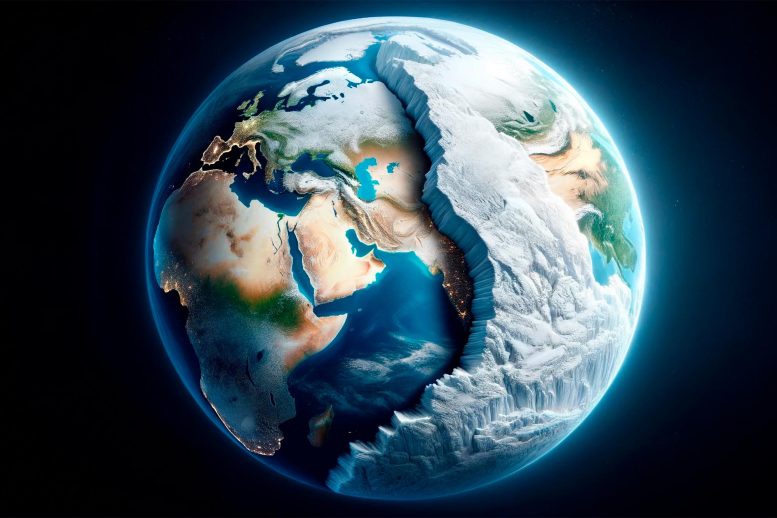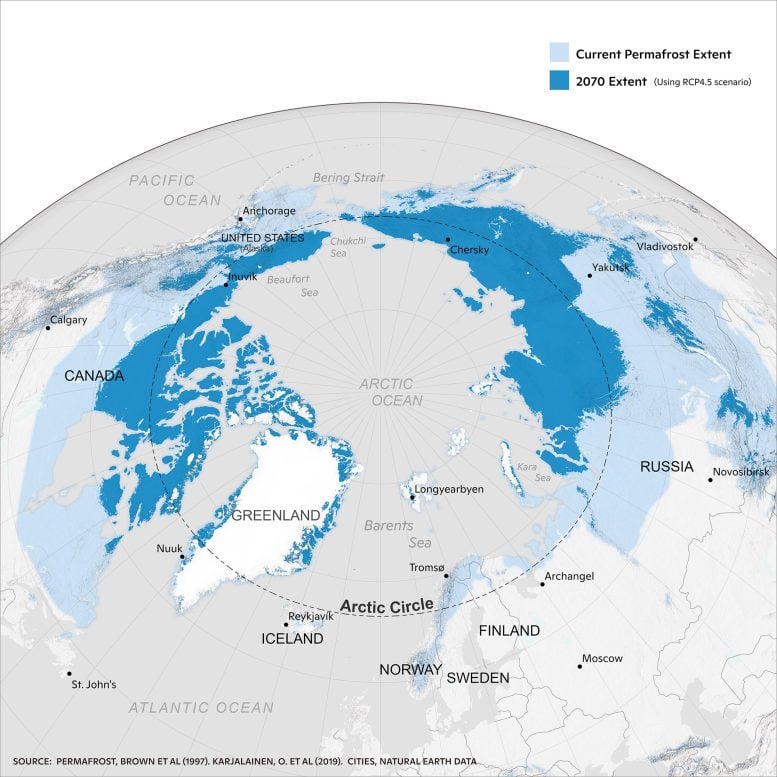
A commentary in Nature Climate Change raises concerns about how science funding affects Earth System Models, particularly in modeling permafrost emissions for climate predictions. The article emphasizes the need for longer-term funding and advanced resources to improve model accuracy and address the challenges of complex climate modeling. Credit: SciTechDaily.com
Funding challenges and complexity have kept permafrost processes out of models that inform global climate targets.
The way science is funded is hampering Earth System Models and may be skewing important climate predictions, according to a new comment published today (January 18) in Nature Climate Change by Woodwell Climate Research Center and an international team of model experts.
Permafrost Emissions and Modeling Challenges
Emissions from thawing permafrost, frozen ground in the North that contains twice as much carbon as the atmosphere does and is thawing due to human-caused climate warming, are one of the largest uncertainties in future climate projections. But accurate representation of permafrost dynamics is missing from the major models that project future carbon emissions.
Only two of the eleven Earth System Models (ESMs) used in the last Intergovernmental Panel on Climate Change (IPCC) report include permafrost carbon cycling at all, and those that do currently use over-simplified approximations that don’t capture the fully dynamic ways that permafrost carbon can be released into the atmosphere as the climate warms. Processes that researchers have observed in the field, such as the way abrupt permafrost thaw can create ponds and lakes and change surface hydrology, run counter to these approximations but have large implications for permafrost carbon and its potential impact on the global climate.

Map depicting current extent of permafrost in Northern Hemisphere (light blue) and projected extent of permafrost in 2070 (dark blue) under RCP 4.5 scenario. Credit: Greg Fiske / Woodwell Climate Research Center
The Need for Accurate Climate Modeling
“What happens to the carbon in permafrost is one of the biggest unknowns about our future climate,” said Christina Schaedel, senior research scientist at Woodwell Climate Research Center and lead author of the report. “Earth System Models are critical to predicting where, how and when this carbon will be released, but modeling teams currently don’t have the resources they need to depict permafrost accurately. If we want more accurate climate predictions, that needs to change.”
Challenges in Model Development and Funding
Earth System Models, the supercomputer-driven programs that can forecast future carbon emissions and climate dynamics, can predict only the processes that they represent. And as scientists learn more about the complex physical and biogeochemical interactions that make up the Earth system, ESMs have grown in complexity, encompassing more and more processes. In practice, that means years of highly technical code development, integrating observational data, and parameterizing and testing the model.
But most science research funding operates on a three-year funding cycle and is structured around projects that tackle novel science questions. This relatively short cycle is too brief a time to train up model developers or to complete key and complex model development steps before teams turn over, the authors say.
“As these modeling systems are becoming increasingly complex, it is hard—and getting harder—for a graduate student or postdoc to ‘come up to speed’ quickly enough to really understand the full scope of the model development needs and wrap up a development project on the typical three-year timeline of a proposal,” said David Lawrence, who co-leads the Community Terrestrial Systems Model at the National Center for Atmospheric Research.
“Unfortunately, that leaves many projects unfinished.” Lawrence, who co-authored the report, said that while the collaborative modeling teams he works with are making advances in depicting complex permafrost processes, limited funding means that “the pace at which improvements get ingested back into the core CTSM codebase is relatively slow.”
Call for Increased Funding and Collaboration
“Substantial funding, on the order of multiple millions of dollars per ESM, is needed to provide the necessary infrastructure and support needed for model development,” the authors write. Such targeted funding and highly skilled software developers and programmers, they contend, can help speed the model improvement that’s underway.
“In recent years, Arctic research has become very collaborative and complex—scientists are not just studying one plant in one location anymore,” said Schaedel. “And while the need for long-term data and complex model development has become ever more apparent, the funding availability has not kept up. We’d like to see funding opportunities match the climate challenges that we’re facing.”
“Our understanding of how permafrost is thawing and emitting carbon has drastically improved over the last 15 years,” said Brendan Rogers, associate scientist at Woodwell Climate Research Center and co-lead of the Permafrost Pathways project. “Funding Earth System Models to represent permafrost thaw would ensure those gains are realized in the models, and that critical climate targets and carbon budgets are being based on the best science we have.”
Reference: “Earth system models must include permafrost carbon processes” by Christina Schädel, Brendan M. Rogers, David M. Lawrence, Charles D. Koven, Victor Brovkin, Eleanor J. Burke, Hélène Genet, Deborah N. Huntzinger, Elchin Jafarov, A. David McGuire, William J. Riley and Susan M. Natali, 18 January 2024, Nature Climate Change.
DOI: 10.1038/s41558-023-01909-9
This comment was authored by scientists from Woodwell Climate Research Center, the National Center for Atmospheric Research, Lawrence Berkeley National Laboratory, Max Planck Institute for Meteorology, The Met Office Hadley Centre, University of Alaska Fairbanks, and Northern Arizona University. Authors received funding from the U.S. Dept. of Energy and Permafrost Pathways through the TED Audacious Project.









“[permafrost] is thawing due to human-caused climate warming, …”
One sees this assertion frequently, but seldom with associated supporting evidence. Reference to the correlation between increasing CO2 and increasing temperature is weak evidence because correlation does not establish causation and the correlation is almost certainly spurious. The seasonal variations are anti-correlated, and when COVID-19 forced a worldwide experiment on the world, there was no evidence that decreased anthropogenic emissions resulted in either the Fall/Winter ramp-up rate, or the seasonal peak (May) in the Northern Hemisphere, decreasing.
https://wattsupwiththat.com/2022/03/22/anthropogenic-co2-and-the-expected-results-from-eliminating-it/
One of the most compelling arguments is the change in the carbon isotope ratio in the atmosphere, with the relative abundance of 12C apparently increasing in recent decades, because plants are enriched with 12C. It is attributed commonly to 12C-enriched fossil fuels shifting the balance. However, those making the claim don’t appear to have looked at the issue in the detail necessary to be certain of the reason.
Isotopic Fractionation is a process where the ratio of two isotopes of the same element changes when the element is involved in a phase change or chemical reaction. When CO2 out-gases from ocean water as a result of decreasing pressure and/or warming, a larger percentage of 12C is released into the atmosphere (because it is lighter) than 13C. This is particularly true for upwelling coastal waters that are from deep, 1,000-year old bottom waters already enriched with 12-C from dead photosynthetic plankton.
Ocean water is also highly buffered, meaning that it strongly resists pH changes by converting between carbonate and bicarbonate species by the action of carbonic acid. These changes are also impacted by temperature and pressure. Isotopic fractionation also occurs with these chemical reactions.
I have yet to come across comprehensive research on the impact of isotopic fractionation at the scope and scale of the Earth System Models. While I agree that more work needs to be done on the permafrost problem, it isn’t the only area of the Earth System Models that is deficient. The science is definitely NOT settled. That is why I think it is dangerous for autocrats to impose significant economic and technological changes on society before we are more confident in the details of the problems and the solutions.